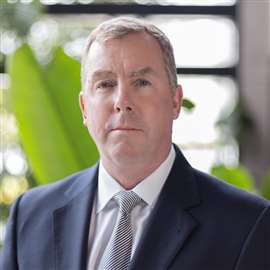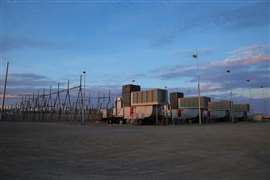New APR looks to capitalise on data centre power “gold rush”
26 March 2025
Large language models and AI tools are driving a surge in demand for power from data centres. Chuck Ferry, chief executive of Duos Technologies and New APR Energy tells Lucy Barnard how his firm is benefitting from the “gold rush” by supplying gas turbines to those unable to connect to the power grid
 Image created using AI via Dall-E3
Image created using AI via Dall-E3
“It’s literally a gold rush right now,” says Chuck Ferry, chief executive of Duos Technologies, a man looking to supply temporary power to some of the US’s largest data centres. “The demand for these assets is off the charts.”
Ferry, a former US Army infantry brigade commander, who spent six years until 2020 leading temporary power specialist APR Energy, is attempting to capitalise on an AI-crazed ballooning of the US data centre market by supplying gas turbines to help power it.
Certainly, an increase in demand for data processing, driven by recent breakthroughs in artificial intelligence is driving up electricity demand among existing data centres – and prompting more data centre development. And each windowless building, filled with rack upon rack of computer servers, requires huge amounts of power, more and more of which, it turns out, is coming from fossil fuel burning turbines.
“We’re in the very enviable situation where we have more data centre customers lined up at the door than we can provide power for,” Ferry says. “It’s a great problem to have.”
Data centre power demand spikes
The International Energy Agency predicts that by next year the total amount of electricity consumed by data centres around the world will stand at around 1,000 terawatt hours – roughly the same level as that of Japan – and double the level consumed in 2022.
For Duos, a tech firm which specializes primarily in producing software to automate railway maintenance inspections, the rapid surge in demand spells opportunity.
The company orchestrated a deal last year to purchase a fleet of 30 gas turbines capable of producing 850MW of power from Atlas Corporation-owned APR Energy and is already deploying the generators at some of the country’s largest data centres.
On 31 December 2024, Duos completed the deal with US-based investment management firm Fortress Investment Group, to purchase the 10 Pratt & Whitney FT8 mobile packs and 20 General Electric TM2500 mobile gas turbines. Each turbine can be fueled by either diesel or natural gas but the company says it prefers to use natural gas due to its lower emissions profile and the fact that overall it is “kinder to the turbines.”
Under the deal, Duos then set up a new company, confusingly named New APR Energy, to own the turbine fleet. New APR Energy is 95% owned by Fortress and 5% owned by Duos. Meanwhile Duos deploys the assets through an asset management agreement and employs 85 staff, at least half of whom work exclusively with the APR assets.
 Chuck Ferry, chief executive of new APR Energy and Duos Technologies. Photo: APR
Chuck Ferry, chief executive of new APR Energy and Duos Technologies. Photo: APR
“These are the exact same turbines that my team and I operated from 2016 to 2020 so it’s kind of like a reunion,” says Ferry. “When I was running APR originally the margins for deploying turbines remained very high so when they came around we knew right away we wanted those turbine assets. We wanted to keep the name APR because it has been well known in the rental temporary power space for many years.”
When asked for the total value of the turbine assets that New APR Energy had acquired, Duos said it did not want to disclose the information.
The sale of the 30 gas-powered turbines also leaves a question mark hanging over the future plans for the original APR Energy which remains in the hands of global asset management company Atlas Corporation. Prior to the sale, the company also operated a fleet of 1400kW and 1640kW diesel power modules as well as a modular photovoltaic system. IRN contacted Atlas Corporation by email and phone for further clarification but had yet to receive a response as the article went to print.
Ferry points out that while competition from other rental energy providers such as Aggreko has driven down rental rates in the diesel generator sector, margins for industrial gas turbines remain far higher. Moreover, in the years since his departure from the original APR Energy, the market for mobile gas turbines in the USA has changed dramatically.
“Four or five years ago these assets were in plentiful supply. There was a glut of equipment on the shelf for OEMs like General Electric or Siemens. But during the pandemic they made a very wise decision to slow their production lines – or in some cases to stop producing these types of assets until they received an order,” he says. “Fast forward to today and you just can’t get hold of assets like these. It’s a two or three year wait right now.”
At the same time, he says, the shortage of suitable turbines on the market coincides with an increasing appetite among data centre operators to search for temporary power solutions – or so called ‘behind the meter power’ which can allow them to work around the limitations of grid availability.
And, by using stocks of LNG rather than drawing power from the grid, it’s a work-around likely to push up carbon emissions among data centres to even higher levels.
Behind the meter power
Last year Google reported that its greenhouse gas emissions rose 48% between 2019 and 2024, driven by energy hungry data centres which play a crucial role in training and operating AI models like Gemini. And Microsoft said that energy use from its data centres was endangering its target of becoming carbon negative by 2030.
“Data centre operators don’t want to use behind the meter power like this,” Ferry says. “They would prefer to connect to a proper utility. But unfortunately, within the last year, the demand has grown so high that the utilities can’t keep up. So data centres are generating their own behind the meter power solutions. They act as bridging solutions until they can connect to the utility or build their own plant – or in some cases until they can build a nuclear power plant.”
For data centre parks which are built out in phases, Ferry says it is becoming more and more common to see the initial phases connected to the grid while later phases required to come up with their own power.
 APR’s gas turbines can run on diesel or LNG. Photo: APR
APR’s gas turbines can run on diesel or LNG. Photo: APR
Currently, Ferry says, APR has already deployed four of its turbines to one of the largest AI-centric data centres in the US to supply a need for an additional 100MW. And the company is in negotiations to supply a further six turbines to another huge data centre operated by the same customer. Rental agreements for these sorts of assets, he says, tend to run for between two and five years in order to allow data centre operators the time to put in place more permanent power arrangements.
On top of this, Ferry says the company plans to continue with its original business of supplying temporary around the world where national grids have become overstretched. The company has provided power around the world to countries including Australia, Egypt, Japan, Libya, Uruaguay and the US Virgin Islands.
The need for LNG bridging power
“In some of those countries they have older technology which is scheduled to come offline and need a bridge or it could be something like a natural disaster. In Ecuador for example, they use a lot of hydro-electric power but the country is currently experiencing drought conditions so that’s driving the need for bridging power. We’ve had an enquiry from Ireland where a large number of data centres operate and the grid is also stressed.”
In 2024 Ireland’s Central Statistics Office reported that datacentres in the country consumed more electricity the previous year than all of its urban homes combined, accounting for 21% of all domestic electricity use – up a fifth on 2022.
Ferry says that Duos is currently looking at adding wind or solar power or battery storage solutions to supplement the gas turbines being used but adds that since Donald Trump became president, pressure to reduce emissions across the country has eased.
“I think the urgency to utilize renewable power has probably diminished right now but it hasn’t gone away,” he says. “It makes things a bit easier for us right now to deploy these gas assets but collectively we believe we can still combine them with renewables and that’s the right thing for a more long-term solution regardless of who is in the administration.”
STAY CONNECTED



Receive the information you need when you need it through our world-leading magazines, newsletters and daily briefings.
CONNECT WITH THE TEAM







